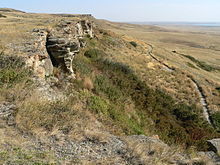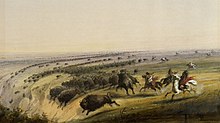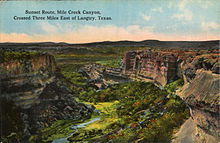|
Buffalo jump
 A buffalo jump, or sometimes bison jump, is a cliff formation which Indigenous peoples of North America historically used to hunt and kill plains bison in mass quantities. The broader term game jump refers to a man-made jump or cliff used for hunting other game, such as reindeer. Method of the hunt Hunters herded the bison and drove them over the cliff; this process would serve to break the buffalos' legs and render them immobile, though often still alive and in great pain. Tribe members would wait below the jump and then close in with spears and bows to finish the kill. The Blackfoot people called the buffalo jumps "pishkun", which loosely translates as "deep blood kettle". They believed that if any buffalo escaped these killings then the rest of the buffalo would learn to avoid humans, which would make future hunts more difficult.[1] Due to the large number of buffalo that would be driven over the cliff, the practice has been criticized as having been highly wasteful. Many of the animals driven over the cliffs did not end up getting harvested as most would rot or go to waste. This was due primarily to the primitive tools and harvesting techniques available to indigenous peoples at the time. Such tools and methods made it impossible to harvest so many dead or dying animals fast enough to beat the onset of rotting, and therefore vast amounts of unharvested, wasted carcasses were left to rot out in the open.[2][3] Buffalo jump sites are often identified by rock cairns, which were markers designating "drive lanes", by which bison would be funneled over the cliff. These drive lanes would often stretch for several miles. Buffalo jump sites yield significant archaeological evidence because processing sites and camps were always nearby. The sites yield information as to how the Native Americans used the bison for food, clothing, and shelter. Plains Indians, in particular, depended on the bison for their survival.[3] In one of his journals, Meriwether Lewis describes how a buffalo jump was practiced during the Lewis and Clark Expedition:
Historical sites  Sites of interest range from Alberta to Texas, including: Head-Smashed-In, Bonfire Shelter, Ulm Pishkun, Madison Buffalo Jump, Dry Island, Glenrock, Big Goose Creek, Cibolo Creek, Vore,[6] Wahkpa Chu'gn (also includes Too Close for Comfort archaeological site),[7] Olsen-Chubbuck Bison Kill Site, and Camp Disappointment of the Lewis and Clark Expedition. Ulm Pishkun Buffalo Jump is likely the largest buffalo jump in the world. It was used by the Native Americans in the area between 900 and 1500 CE. The cliffs themselves stretch for more than a mile and the site below has compacted bison bones nearly 13 feet (4.0 m) deep, a testament to how many of the killed buffalo went unharvested by tribal peoples.[8] Ulm Pishkun Buffalo Jump is located in First Peoples Buffalo Jump State Park in Cascade County, Montana, north-northwest of the community of Ulm. Madison Buffalo Jump State Park is a Montana state park in Gallatin County, Montana in the United States. The park is 638 acres (258 ha) and sits at an elevation of 4,554 feet (1,388 m).[9] The park is named for a canyon cliff used by Native Americans as a buffalo jump, where herds of bison were stampeded over the cliff as a means of mass slaughter.[10] This limestone cliff was used for 2,000 years by Native Americans.[11] Madison Buffalo Jump State Park is a day use-only park. It is open year-round for hiking, wildlife observation, and some picnicking.[10] Camp Disappointment, the northernmost point of the Lewis and Clark Expedition, is among the best-preserved buffalo jumps in Montana, due to its relatively inaccessible location. The creek at the bottom of the cliff periodically exposes bones of animals that were not harvested.[12] There is a 3-D reconstruction of Charles M. Russell's painting of a buffalo jump on display at the Helena State Capital Museum, Helena, Montana. See alsoWikimedia Commons has media related to Buffalo jumps.
References
|